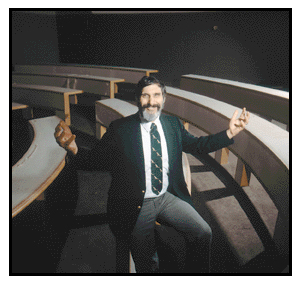| Ranked by Business Week as one of the top 10 business
schools in America, the John E. Anderson Graduate School
of Management at UCLA is on the verge of a rare
opportunity to completely reengineer its computer
infrastructure. In June, the Anderson School is scheduled
to move into a new six-tower building that's custom-built
to the school's specifications. Years of careful
planning — and fund-raising — will culminate in new computer
labs, classrooms, libraries, offices, conference rooms,
and a centralized computing center — all tied together by a
state-of-the-art "virtual network" that discards nearly 40
years' worth of legacy equipment and cabling. UCLA's business school has had a long tradition of cutting-edge technology and business-oriented computer training. In 1957, IBM established the Western Data Processing Center at UCLA, a groundbreaking installation. The original "glass house" that enclosed the IBM mainframe still stands in the Anderson School's present-day building, and large parts of IBM's 360 operating system were written in rooms that are now occupied by faculty members and student computer labs. As computers evolved, so did the business school. UCLA moved from punch cards to DECwriters to video terminals — and, in the 1980s, to microcomputers. In the mid-1980s, another IBM grant allowed UCLA to become one of the country's first totally networked business schools. Additional grants from Hewlett-Packard and Apple allowed the school to set up labs with scores of PCs and Macs, all linked to an HP minicomputer running a custom E-mail system for the 1200 students, 100 faculty members, and 180 staff personnel. Today, a new HP 9000-H70 superminicomputer handles an astounding 350,000 to 500,000 E-mail messages per week, mostly internal. Why so much E-mail? A major factor is that Anderson's MBA programs strongly emphasize team projects. In addition to the frequent break-out sessions associated with regular classes, second-year MBA candidates must complete a field-study project with a team of fellow students. "You deal with a client, you interface with them, and there's a lot of coordination that goes on between you and your teammates," explains Max Shoka, an electrical engineer and second-year MBA student. "We don't have any central office, we're doing a thousand things, and we need ways of passing information back and forth," he adds. Anderson's current patchwork of 10 servers (variously running HP-UX, NetWare 3.12 and 4.01, AppleShare 4.0, and OS/2 1.3) and about 400 client machines is straining under the load of this traffic. Most users access the E-mail network over 9600-bps serial lines; only a minority have 10-Mbps 10Base-2 Ethernet connections. The network is further stressed by students dialing in from the outside. About 80 percent of them have their own computers, including 420 executive MBA students who work full-time jobs and connect remotely from university-supplied PowerBook 170 and 540c notebooks. Next fall, every Anderson student will be required to own a computer; in the fall of 1996, they may be required to own a laptop. Future Vision To cope with this wired environment and allow room for growth in the future, the new 280,000-square-foot building is a network manager's dream. The school's aggregate network bandwidth will be 30,000 to 50,000 times greater than before, and the entire network has been redesigned from scratch. Every seat in every classroom, library, and office — 2462 locations in all — will be wired with power outlets and 10Base-T Ethernet connections. Small break-out rooms will be wired so that teams of students can set up ad hoc networks with their laptops. Each classroom will have a computer built into the instructor's podium and a video projector suspended from the ceiling, so any screen in the room can be displayed to the whole class. New labs will be equipped with dozens of PCs, Power Macs, and multimedia gizmos, including scanners, video-capture boards, camcorders, and color printers. Everything will be tied into a central computer room over a backbone of fiber-optic cables and ATM (Asynchronous Transfer Mode) switches. David VanMiddlesworth, the network manager, says ATM was chosen because it has great bandwidth, can handle isochronous transmission, and is relatively easy to reconfigure on the fly. Profuse networking and a highly computer-literate student body will let the school deliver lessons that require students to browse the Internet and analyze information from diverse sources. "That's what life is going to be like for the MBAs when they leave here," says VanMiddlesworth. "We have to give them the tools to do that." Organization: John E. Anderson Graduate School of
Management, UCLA  Tom R. Halfhill is a BYTE senior news editor based in San Mateo, California. You can contact him on the Internet or BIX at thalfhill@bix.com. Copyright 1994-1998 BYTE |